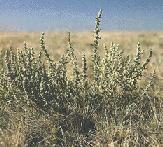

Nuttall's Saltbush
Atriplex nuttallii S. Watson.
Nuttall's saltbush is a native, spreading, low-growing,
evergreen, perennial sub-shrub. It grows from 8 to 20 inches in height and has
alternate leaves 1/2 to 2+ inches long. Herbaceous flowering stems rise
above the woody, decumbent portion of the plant Saltbush has alternate,
linear-oblong, stalkless leaves. Leaves are 1 to 2 inches and 6 times as long as they are wide.
Leaves are green-gray and scruffy. Flowers are small in small auxiliary clusters with fruiting brackets.
Requires a light or medium well-drained but not too fertile soil in a
sunny position. Tolerates saline and very alkaline soil. Succeeds in a hot dry
position. Male and female flowers are usually on separate plants.
Food Uses: Leaves and stems are cooked, usually cooked with wheat. The
leaves and stems can be used to add a salty flavor to other cooked foods.
Seed are also cooked to be used in piņole or ground into a meal and used as a
thickener in making bread or mixed with flour in making bread.
Value to Animals:
Like other saltbushes, it is a valuable browse species, providing a source of
palatable, nutritious forage for a wide variety of wildlife. The fruits and
leaves are a food source for deer,, desert bighorn sheep, pronghorn, small
rodents, jackrabbits, game birds, and songbirds. Areas of saltbush provide cover
and forage for black-tailed jackrabbits.
Planting: Plan to obtain cuttings of half-ripe wood in a July/August.
Very easy. Pot up as soon as they start to root (about 3 weeks) and plant out in
their permanent positions late in the following spring. Cuttings of mature wood of the current season's growth should be in the
November/December time frame. Very easy. Pot up in early spring and plant out in
their permanent position in early summer.